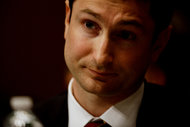The company’s board voted to approve a dividend of 4 cents a share to all shareholders of record as of Oct. 9, 2013. It will be paid on Oct. 24, the week before The Times announces its third-quarter earnings. The Times has not paid a dividend since Dec. 14, 2008.
The dividend, which applies to both Class A and Class B shares, will cost the company roughly $24 million a year.
In a statement, Mark Thompson, president and chief executive of The Times, said that the board had concluded “that the strength of the balance sheet justified the restoration of a dividend.”
But Mr. Thompson warned that the company would remain cautious in its financial strategy.
“Given the expectation of continued volatility in advertising revenue and the fact that our growth strategy is at an early stage of development, we will maintain a prudent view of both the balance sheet and free cash flow,” he said.
During recent earnings calls, analysts have repeatedly asked Times executives to issue a dividend. In the first quarter of 2013, analysts noted that there was a sell-off of the company’s stock after management announced it would not issue a dividend because of concern about the financial state of the media industry. But in August, The Times reported that it had swung to a profit from stronger circulation revenue and lower operating costs.
John Janedis, an analyst with UBS, said that it made sense for The Times to issue a dividend now because the company was selling its final noncore asset, The New England Media Group, which includes The Boston Globe. After that sale closes next month, The Times will be able to focus exclusively on building its core brand, The New York Times.
“You basically have a clean balance sheet, you have free cash flow at the company,” Mr. Janedis said. He added that a dividend also made sense “given how much the company has slimmed down in terms of assets.”
Mr. Janedis estimated that The Times could afford to pay shareholders the dividend despite the media industry’s financial challenges.
“Even if the ad market weakens further and there is virtually zero return on their growth initiatives, they can easily fund the dividend if not increase it,” Mr. Janedis said.
In its last earnings report, The Times reported that, as of June 30, it had cash and securities totaling about $918 million.

Article source: http://www.nytimes.com/2013/09/20/business/media/new-york-times-company-to-start-paying-dividend.html?partner=rss&emc=rss









